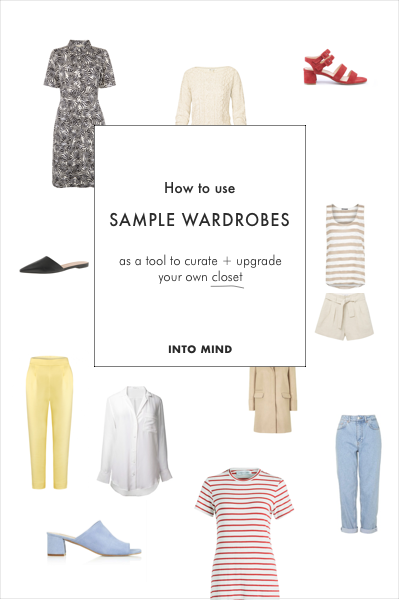How to use sample wardrobes as a tool to curate + upgrade your own closet
Not long ago fashion blogging was all about capturing great style at the outfit level. Being a fashion blogger meant posting lots and lots of well-styled outfits, ideally without ever repeating the same piece.
Those type of fashion blogs are still going strong of course. I keep plenty of them on my blogroll myself, because they’re just an amazing source of unique outfit ideas.
But let’s be honest: Fashion bloggers like that are not the most practical role models when it comes to being stylish in everyday life. They can afford to never wear the same thing twice because they get sent a bunch of free stuff. But the rest of us have to re-wear pieces! And that’s why to dress well in real life, it’s not enough to know how to build great outfits - you also need to know how to build a great wardrobe.
Fortunately, there are now plenty of bloggers out there who focus on wardrobes, rather than outfits, and everyday I see a new sample wardrobe pop up on my feed (like this or this one). And of course, I have also posted a fair share of sample wardrobes here on the blog, the last one being this week’s 20-piece Summer Capsule Wardrobe.
If you are on a mission to upgrade your own closet, sample wardrobes like these can be a helpful learning tool - if you keep a few basic principles in mind.
Focus on the wardrobe as a whole, not individual items
Sample wardrobes are not magazines shopping features that you skim through looking for a piece to spend your next paycheck on. Instead, they are supposed to give you an example of how certain types of items could work together to create a fully functioning “organism”, i.e. wardrobe. The focus here is on types of items, so try to pay attention to the main features of the pieces (like color, cut, and overall style) - and dot get hung up on what brand they are from, whether you can afford them, wether you like the material or a minor detail (like embroidery around the neckline or a zipper instead of buttons).
Because, again, the goal is not for you to buy those exact pieces but rather to illustrate an idea.
Analyse the structure of the wardrobe
Most sample wardrobes that you’ll see on blogs won’t be accompanied by a blow-by-blow account of the blogger’s creative thought process behind it. The trouble is, that thought process is really what you are after, because that’s what will help you improve your own closet. The solution: Do the legwork yourself. Dedicate a few minutes to analyse the overall structure of the sample wardrobe you are looking at. Use these questions to make sure you cover every major characteristic of the wardrobe:
- How would you describe the overall style of the wardrobe?
- What type of lifestyle and activities is this wardrobe tailored to?
- Which item categories (e.g. skirts, longsleeve shirts, heels, etc.) are included in this wardrobe and how many pieces are there per category?
- What outfit formulas could be created with this wardrobe?
- What is the colour palette of this wardrobe? How many pieces are included for each colour?
- What is the ratio between neutral basics and bolder statement pieces?
Assess how well the wardrobe would work for your own life and style
As you analyse the different components of the wardrobe, like the colour palette or the number of pants vs. skirts, keep asking yourself how well they would work for your own life and personal style.
Focus on what you like about the wardrobe, but also on what you don’t like about it, and more importantly: why?
Let’s say the sample wardrobe contains four pairs of heels and only one pair of flat shoes. Would you be happy wearing mostly heels? If not, how many pairs of flats would you prefer instead and why?
Another example:
Let’s say you are taking a look at the item categories of the Summer capsule wardrobe I posted this week. There are three dresses, three skirts and three pairs of pants, and they are supposed to be worn to the office as well as for weekends and free-time. Would that work for you? Or would you prefer to have a few more pairs of shorts to choose from, because you tend to live in shorts during the Summer? Would you be happier swapping some of the skirts for pants because you feel more comfortable wearing pants to the office?
What do you think of all of the warm bold colours and the patterns? Could you see yourself wearing these during the day, or would you prefer a few more neutrals in the mix?
Come up with actionable takeaways
As a last step, jot down some key takeaways, like ideas for new outfit combinations, pieces you want to buy or just general thoughts about your personal style or the state of your wardrobe. Perhaps you realised you really need another pair of jeans to wear with your casual tops? Or maybe you want to try out a specific colour combination. Or maybe you figured out what you need to pack for your Summer holiday. Write it all down, so you won’t forget and can act on it (right now or during your next wardrobe overhaul).




